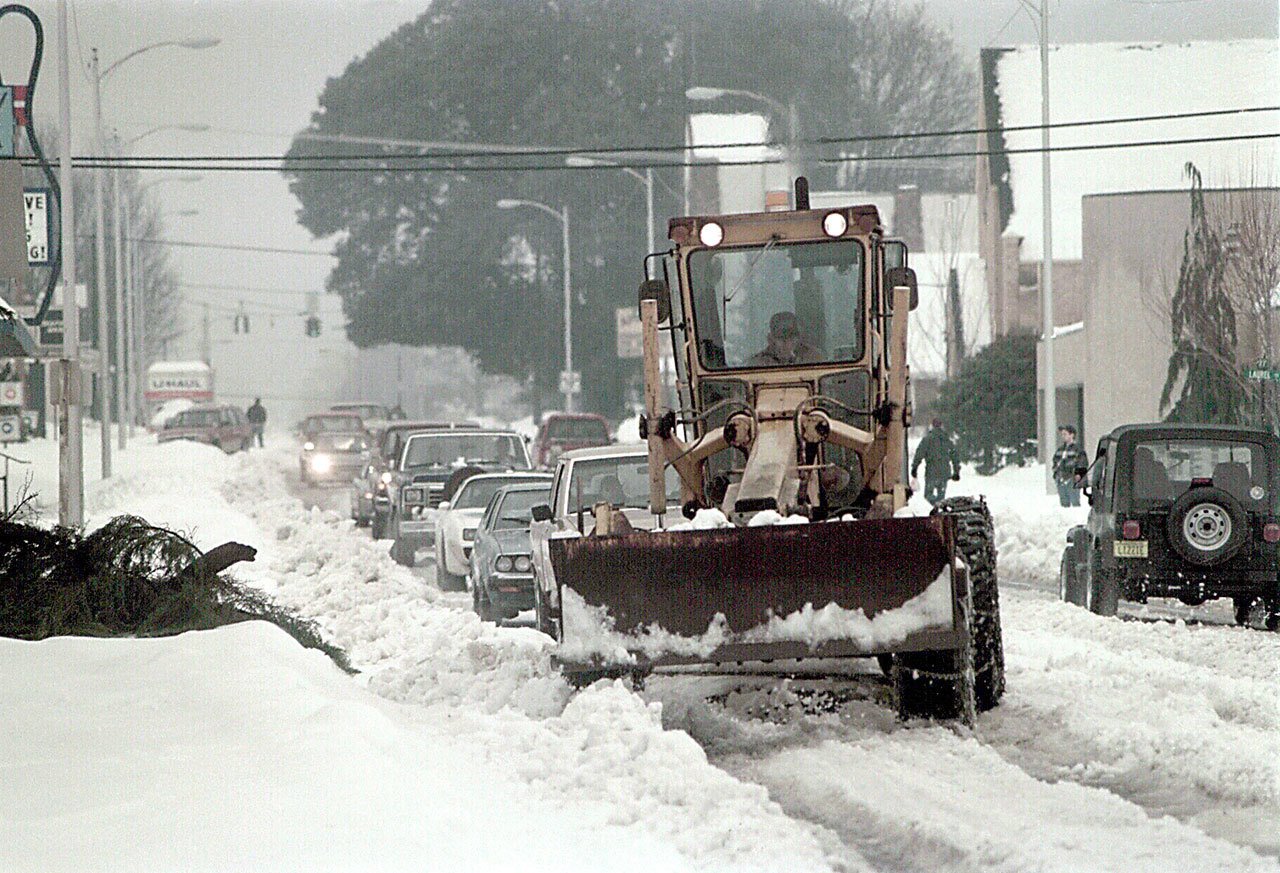PORT ANGELES — My first thoughts upon looking out the window were “I’ve seen worse.”
Little did I realize that most of my colleagues and many of my neighbors really hadn’t seen worse and that this was a historic event.
Having moved to Port Angeles from Iowa just months before to take a position as photographer and writer for the Peninsula Daily News, I never thought of snow on its own as a show-stopper. In the Midwest, you just slap on the chains, toss the snow shovel in the trunk and soldier on.
That didn’t work on the morning of Saturday, Dec. 28, 1996. After several days of lesser snowfalls, snow began falling in earnest Friday, and by Saturday morning, as much as 2 feet had accumulated near the Port Angeles waterfront with greater amounts away from the water.
The city was becoming overwhelmed.
Plows had managed to keep a passable lane on Front, First and Lincoln streets — the official route of U.S. Highway 101 — but little else had been touched by Saturday. Having a few main routes clear was a commendable effort, but you still had to get to those routes. Most residents had no way of doing that, myself included.
Making matters worse, in the later hours of the storm, rain became mixed in with the flakes, adding to the heavy load of white on buildings around the North Olympic Peninsula. The police scanner was getting very busy with reports of building collapses, threatened structures and other weather-related maladies. Travel was difficult if not impossible.
A few of us PDN folks decided to walk to work that day. We had a newspaper to produce and this was becoming one of the biggest news stories of 1996.
On the way downtown, the sound of stuck cars spinning their wheels on the slick, slushy muck waifted in from all directions. Many people left their buried cars in their driveways and, like myself, set out into a winter wonderland-turned-nightmare on foot.
A colleague and myself went into disaster triage-mode. With an obviously huge story confronting us, the question was “what can we even get to?” On that first day of the Great Dig Out, it wasn’t much.
Again, on foot, we visited Port Angeles Boat Haven where an effort was underway to save boats from beneath collapsed boat houses and from sinking docks, burdened with the weight of several tons of snow and slush. Additional boat houses would later succumb to storm.
From there, I set out on my own to trudge up to Lincoln and Eighth streets where a roof had collapsed on a business and plows were just getting to the main arterials.
Of those who had decided to venture out into the aftermath of the storm, the mood was either one of delight with the snow or else one of being dumbstruck by the enormity of the event. There didn’t seem to be much of a middle ground.
With a skeleton staff, the next-day’s edition of the PDN was printed, but it would be days before many people received their newspapers. Most of the carriers had no way of reaching subscribers along their snow-clogged routes, making a shambles of home-delivery.
Another round of heavy, wet snow on Saturday night and into Sunday morning wreaked more havoc, triggering additional building collapses. In Port Angeles, storm damage included buildings at the Clallam County Fairgrounds, businesses along U.S. Highway 101 west of the city and the Department of Health and Human Services building at Washington and First streets.
But life goes on.
In the days that followed, then-Gov. Mike Lowery toured portions of the Peninsula and was astounded by the amount of damage from collapsed buildings and strained infrastructure. He vowed assistance from the state if needed.
Plows got to the major routes and eventually most of the side streets. Cars got dug out, although not as quickly as many would have liked.
Hardware stores ran out of snow shovels and personal snow blowers worked for days to clear sidewalks and driveways. Some alleys remained icy for weeks and piles of dirty snow lasted until the spring melt.
Although there would be numerous snow storms to follow, including several significant traffic-snarling dumpings, the storm of December 1996 would be considered in the minds of many to be one of those, “Where were you when….?” occurrences.
________
Keith Thorpe is a photojournalist for the Peninsula Daily News.

